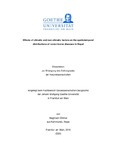Please use this identifier to cite or link to this item:
http://archive.nnl.gov.np:8080/handle/123456789/405| Title: | Effects of climatic and non-climatic factors on the spatiotemporal distributions of vector-borne diseases in Nepal |
| Authors: | Dhimal, Meghnath |
| Keywords: | Vector-borne diseases Malaria control -- Nepal Climate change |
| Issue Date: | 10-Dec-2017 |
| Abstract: | Diseases that are transmitted through the bite or bites of insects and other arthropods (so-called vector-borne diseases, VBDs) threaten the health and lives of billions of people every year. Due to the rapid environmental changes of our time, including the human-induced climate change, the occurrence and spread of vectors and pathogens, and thus the threat of diseases has increased over the years. Nepal is one of the most vulnerable mountainous countries in the world concerning the adverse effects of climate change. Despite its mountainous terrain for which this Himalayan country is a popular tourist destination, Nepal is now endemic for five major VBDs, i.e., malaria, lymphatic filariasis, Japanese encephalitis, visceral leishmaniasis and dengue fever (Chikungunya virus infection has also recently been reported). All of these diseases are caused by pathogens that are transmitted to or among humans by insect vectors. These insects (mosquitoes and sand flies) are sensitive to temperature, rainfall and humidity change and thus ultimately to climate change. Climatological studies show that the warming rate is more pronounced in the highlands of Nepal indicating a higher risk of VBD transmission in the mountain regions. Accordingly, a series of autochthonous cases of VBDs have already been reported from non-endemic mountain regions of Nepal. The convergence of these events and facts raises concerns about a shift of VBDs to higher altitudes of Nepal. However, there are not any studies about how climatic and non-climatic factors affect the spatial and temporal distribution of VBDs in Nepal. The aim of this study was therefore to evaluate the effects of both climatic and non-climatic factors on the spatiotemporal distribution of VBDs in Nepal. Both prospective and retrospective studies were carried out using primary and secondary data. The effects of climatic and non-climatic factors on VBD distribution and transmission were evaluated using a statistical modeling approach. The burden of VBDs in Nepal has over the years significantly declined in endemic areas after the introduction of various vector-control interventions, new and effective medicines, vaccines for those diseases that are vaccine preventable, and the improvement of the health care system and socio-economic status of people especially in the last decade, despite a long armed conflict in the country (1996-2006). However, this declining trend of disease burden is not uniform across the county. Analyses of association of climatic factors with VBDs and their vectors show a significant association. Thus, an effect of climate change on the spatiotemporal distribution of vector-borne diseases is evident in Nepal. For example, malaria was previously considered to be a seasonal disease in this country with a peak incidence in the monsoon season, but now it seems to be perennial in endemic areas, and autochthonous cases of all VBDs have increasingly been reported from non-endemic areas including mountain regions over the last decade. The establishment of populations of disease vectors (with reports of eggs, larvae and adult stages of mosquitoes) at more than 2,000 m above sea level suggests that climate change can increase the altitudinal ceiling of vector distribution as well as the length of transmission seasons. This can potentially put mountain regions of Nepal at the risk of VBD epidemics in the future provided that the domestic environments that are commonly exploited by the vectors are also available in the climatically newly suitable areas. Additional factors that can increase the epidemic potential of VBDs in the mountain regions of Nepal include the lack of immunity of mountain people against VBDs, a low knowledge of people about the prevention and control of VBDs, the absence of VBD control programmes in mountain regions, and the increase in the movement of people, trade and travel, and import of VBD cases from other endemic areas. Therefore, the findings of this dissertation suggest the need of scaling up VBD programmes including monitoring and surveillance in areas previously considered nonendemic such as mountain regions. Furthermore, long-term studies are needed to evaluate the attribution of climate change on VBDs in Nepal. |
| Description: | Dissertation to obtain the doctoral degree of the natural sciences submitted to the Department of Geosciences / Geography the Johann Wolfgang Goethe University, 2014. |
| URI: | http://103.69.125.248:8080/xmlui/handle/123456789/405 |
| Appears in Collections: | 600 Technology (Applied sciences) |
Files in This Item:
| File | Description | Size | Format | |
|---|---|---|---|---|
| PhD Thesis final 31 March 2015.pdf | 4.15 MB | Adobe PDF |  View/Open |
Items in DSpace are protected by copyright, with all rights reserved, unless otherwise indicated.